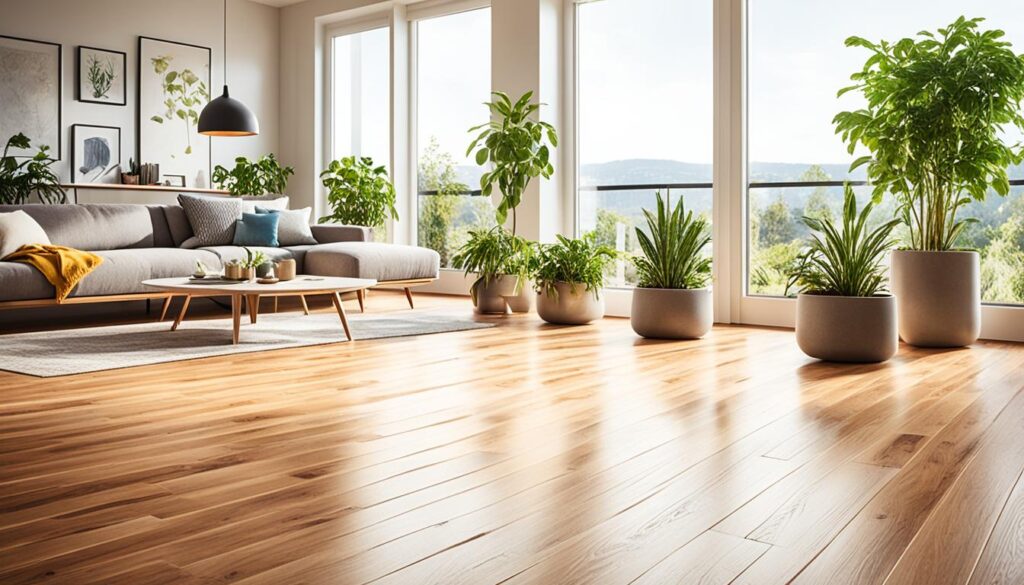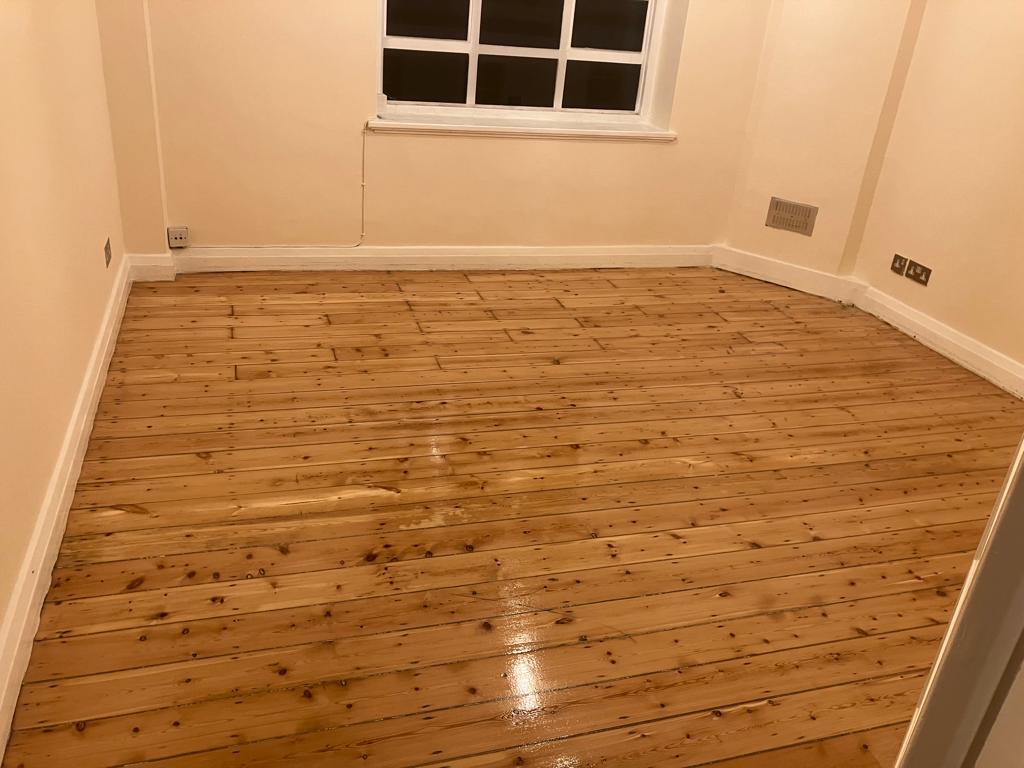The COVID-19 pandemic has led to increased focus on improving the looks of homes and creating healthier living environments. Wood flooring is considered one of the most environmentally friendly options available, as the raw materials used to make it can regrow. Sustainable practices and initiatives in the wood flooring industry have gained traction, with a growing number of people showing a preference for sustainable products. Life Cycle Assessments (LCAs) have shown the overall benefit of wood flooring as a renewable product, with the ability to store carbon and utilise renewable energy sources. Refinishing wood floors instead of replacing them can significantly reduce carbon emissions and energy consumption.
Wood floor longevity is not only dependent on the initial quality but also on the maintenance practices followed. With proper care and regular maintenance, wood floors can last for generations, providing enduring beauty and durability. In this article, we will explore the best practices for maintaining wood floors and ensuring their longevity.
Key Takeaways:
- Wood flooring is an environmentally friendly option due to its renewable raw materials.
- Refinishing wood floors instead of replacing them reduces carbon emissions and energy consumption.
- Maintaining wood floors properly can extend their lifespan and enhance their durability.
- Architects and designers play a crucial role in specifying sustainable wood flooring options.
- Choosing eco-friendly finishes and following proper maintenance practices are essential for wood floor longevity.
The Benefits of Refinishing Wood Floors
Prolonging Wood Floor Lifespan | Increasing Wood Floor Durability | Maintenance Tips for Wood Floors
Refinishing wood floors is a valuable practice that can significantly extend their lifespan and enhance their durability. It goes beyond mere aesthetics and offers numerous benefits that contribute to the overall sustainability and longevity of wood floors.
According to a study conducted by the IVL Swedish Environmental Research Institute, refinishing wood floors can lead to a remarkable reduction of carbon emissions by up to 79% compared to completely replacing the flooring surface. Additionally, it saves a substantial 95% in energy resources, making it a more environmentally friendly choice. The study’s findings highlight the significant impact of refinishing in reducing the carbon footprint associated with wood floor maintenance.
Refinishing wood floors also allows for customization, providing the opportunity to change colors, textures, and sheen levels without the need for replacement. This flexibility enables homeowners to adapt their floors to evolving design preferences or match existing interior themes.
By educating homeowners about the benefits of refinishing and promoting sustainable practices, the wood flooring industry can further enhance the longevity of wood floors. Encouraging regular maintenance, including refinishing, ensures that wood floors remain in optimal condition and continue to provide their many advantages for an extended period.
Refinishing wood floors is a cost-effective and environmentally conscious solution that contributes to the overall sustainability of wood flooring installations. By proactively following the maintenance tips listed below, homeowners can maximize the lifespan and durability of their wood floors:
- Regularly clean wood floors using manufacturer-recommended mild cleaning solutions to prevent damage and maintain their natural beauty.
- Avoid using harsh chemicals that can strip away the protective finish and compromise the integrity of the wood surface.
- Protect wood floors from furniture scratches by using protective pads or felt sliders. Placing area rugs in high-traffic areas can also help reduce wear and tear.
- Maintain proper indoor humidity levels to prevent excessive expansion or contraction of the wood. Use humidifiers during dry seasons and ensure good ventilation in humid climates.
- Promptly clean up spills to prevent moisture penetration and potential damage to the wood.
Implementing these maintenance tips and periodically refinishing wood floors not only increases their lifespan but also enhances their durability, ensuring that they can withstand the test of time and continue to provide long-term value.
Quote:
“Refinishing wood floors is a sustainable solution that not only prolongs their lifespan but also reduces carbon emissions and saves energy resources compared to replacement.” – IVL Swedish Environmental Research Institute
Example of Wood Floor Maintenance Timeline:
| Year | Maintenance Task |
|---|---|
| 1 | Initial installation and finishing |
| 5 | First thorough cleaning and inspection |
| 10 | Light sanding and refinishing |
| 15 | Deep cleaning and refinishing |
| 20 | Full sanding and refinishing |
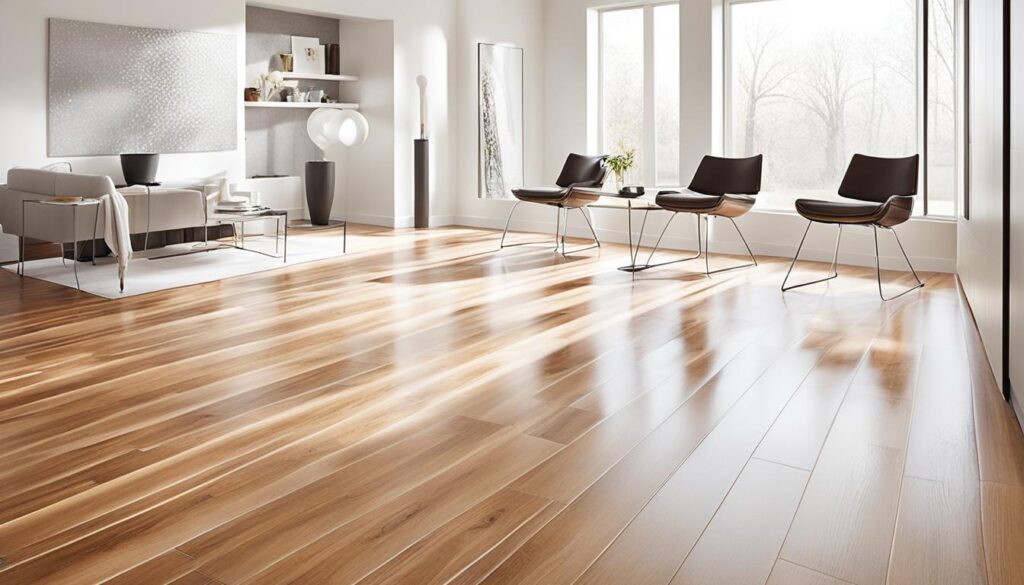
Choosing Sustainable Wood Flooring Options
Architects and designers play a crucial role in specifying sustainable wood flooring options. When it comes to sustainable wood flooring, there are two main options to consider: solid prefinished hardwood and site-finished hardwood.
Solid Prefinished Hardwood
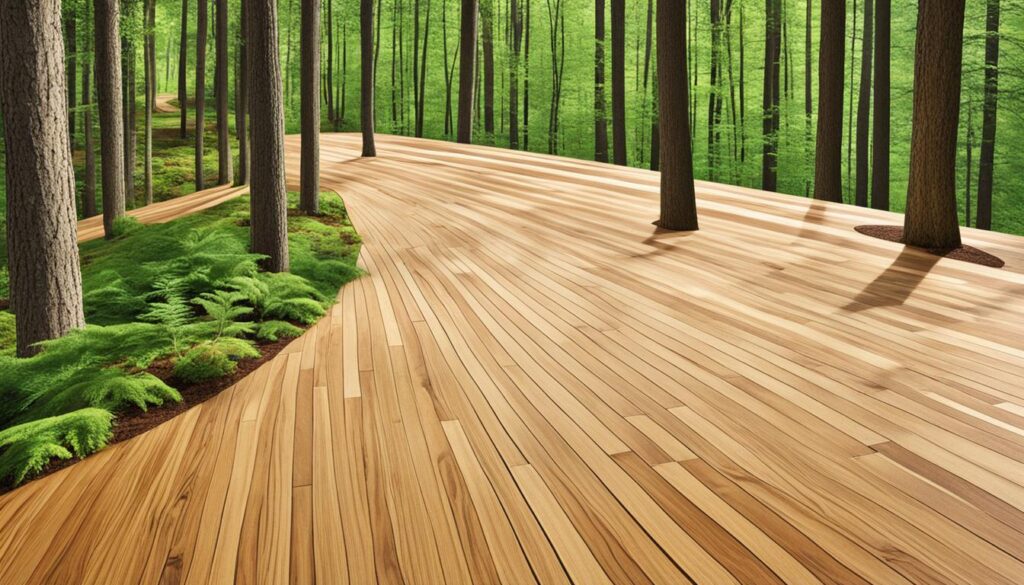
Solid prefinished hardwood is a popular choice among eco-conscious homeowners and builders. This type of flooring arrives at the job site already finished, which means it can be installed quickly and easily. Prefinished wood flooring offers a range of eco-friendly benefits:
- Renewable Resource: Like all wood flooring, solid prefinished hardwood is made from a renewable resource, making it an environmentally sustainable choice.
- Durable: Prefinished hardwood is finished in a controlled factory environment, ensuring a durable and long-lasting surface that can withstand daily wear and tear.
- Refinishing Option: Should the need arise, solid prefinished hardwood can be refinished to restore its original beauty, prolonging its lifespan.
Site-Finished Hardwood
Site-finished hardwood, also known as unfinished hardwood, offers a different set of advantages for those seeking sustainable wood flooring:
- Customization: Site-finished hardwood allows for greater customization and design flexibility. It can be sanded, stained, and finished on-site to achieve the desired look and feel.
- Eco-Friendly: Similar to prefinished hardwood, site-finished hardwood is made from a renewable resource and can be refinished to extend its lifespan.
- Architectural Integration: Site-finished hardwood can be seamlessly integrated into the design of a space, as the finishing process can be tailored to match the surrounding aesthetic.
Architects and designers should prioritize specifying Forest Stewardship Council (FSC) certified wood for both prefinished and site-finished hardwood. This certification ensures responsible forest management, promoting sustainability in the wood flooring industry.
| Sustainable Wood Flooring Options | Prefinished Hardwood | Site-Finished Hardwood |
|---|---|---|
| Eco-Friendly | ✓ | ✓ |
| Durable | ✓ | – |
| Refinishing Option | ✓ | ✓ |
| Customization | – | ✓ |
| Architectural Integration | – | ✓ |
Eco-Friendly Finishes for Wood Floors
When it comes to wood floors, choosing eco-friendly finishes is key to creating a sustainable and healthy living environment. Waterborne floor finishes are an excellent choice for those seeking environmentally friendly options. These finishes are designed to have low Volatile Organic Compounds (VOCs), which means they release fewer harmful chemicals into the air compared to traditional oil-based finishes. This makes them safe for both the occupants of the space and the planet.
One of the significant benefits of waterborne floor finishes is that they dry faster than their oil-based counterparts. This not only saves time during the installation process but also reduces the waiting time for occupants to move back into the space. Additionally, since waterborne finishes contain no harmful fumes, they are an ideal choice for people with chemical sensitivities.
Architects and designers play a crucial role in specifying eco-friendly finishes for wood floors. It’s essential to verify that the finishing products they recommend meet strict environmental certifications such as GREENGUARD and Green Seal. These certifications ensure that the finishes have undergone rigorous testing to meet the highest standards for indoor air quality and sustainability.
Bona, a well-known brand in the wood floor industry, offers a range of waterborne floor finishes that tick all the boxes for eco-conscious homeowners and professionals. Their finishes not only provide excellent durability and protection but are also VOC compliant and GREENGUARD certified, further attesting to their commitment to sustainability.
By choosing waterborne floor finishes and supporting brands like Bona that prioritize sustainability, architects, and designers can contribute to a greener future while still achieving beautiful and long-lasting wood floor installations.

| Benefits of Waterborne Floor Finishes |
|---|
| Low VOCs |
| No harmful fumes |
| Safe for people with chemical sensitivities |
| Dries faster than oil-based finishes |
| Contributes to better indoor air quality |
| Environmentally friendly |
Proper Maintenance for Wood Floors
Proper maintenance is essential for prolonging the longevity of wood floors. By following a regular cleaning routine and using mild cleaning solutions recommended by the manufacturer, you can prevent damage to the wood surface and ensure its long-lasting beauty. Avoiding the use of harsh chemicals is crucial, as they can strip away the protective finish and cause discoloration.
Protecting your wood floors from furniture is another key aspect of maintenance. Place felt pads under the legs of chairs, tables, and other furniture to prevent scratches and dents. Additionally, using area rugs in high-traffic areas can help reduce wear and tear, providing an extra layer of protection for your wood floors.
Controlling indoor humidity levels is vital for maintaining wood floor durability. Excessive moisture can cause wood to expand, leading to warping or cupping. On the other hand, low humidity can cause the wood to shrink and potentially develop gaps. Aim for a relative humidity level between 35% and 55% to keep your wood floors in optimal condition. Use a humidifier during dry seasons and a dehumidifier in humid climates to achieve the ideal humidity range.
“Proper maintenance is essential for prolonging the longevity of wood floors.”
Promptly cleaning up spills is another important aspect of wood floor care. Wood is susceptible to water damage, so it’s crucial to wipe up any liquid spills immediately to prevent them from seeping into the wood and causing stains or warping. Use a soft, absorbent cloth to blot the spill and dry the area thoroughly.
Regular inspections of your wood floors can help you identify any issues early on, allowing for prompt maintenance. Look for signs of wear, such as scratches, dents, or fading, and address them accordingly. If necessary, seek professional maintenance services to revitalize the appearance of your wood floors and resolve any underlying issues.
Remember that each wood floor is unique and may have specific care instructions from the manufacturer. Always refer to the manufacturer’s guidelines for the best maintenance practices specific to your wood flooring type.
Summary of Wood Floor Maintenance Tips:
- Follow a regular cleaning routine using mild cleaning solutions
- Avoid using harsh chemicals on the wood surface
- Use felt pads under furniture legs to prevent scratches and dents
- Place area rugs in high-traffic areas to reduce wear and tear
- Maintain indoor humidity levels between 35% and 55%
- Clean up spills immediately to prevent water damage
- Regularly inspect your wood floors for signs of wear and address any issues promptly
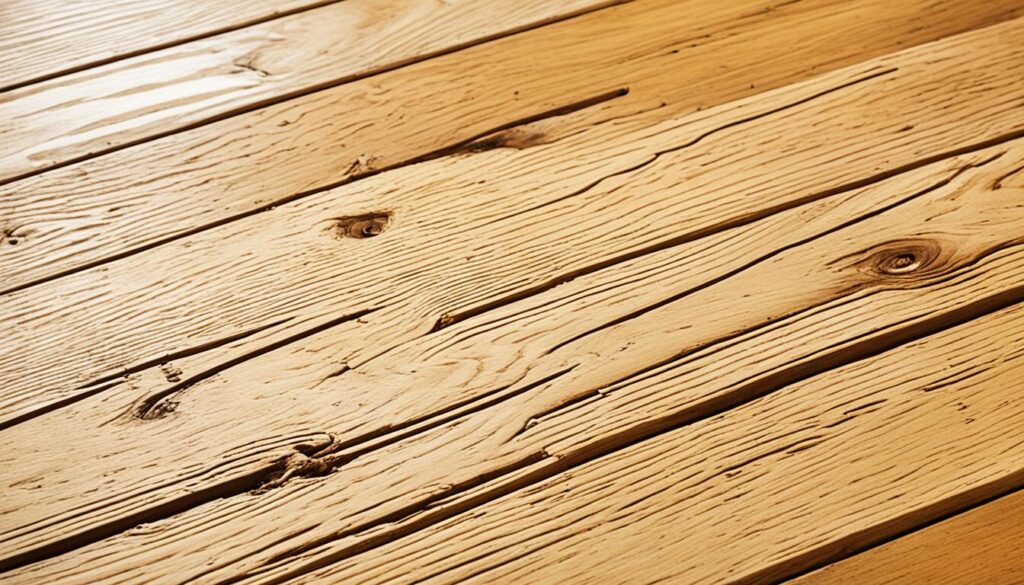
Conclusion
Sustainable maintenance practices are vital for ensuring the longevity of wood floors. The wood flooring industry has a compelling sustainability story to tell, with its renewable nature and the ability to refinish and extend the service life of wood floors. By promoting sustainable practices, educating homeowners, and specifying eco-friendly products, architects and designers can contribute to a circular economy in the building industry and create beautiful, durable, and sustainable wood floor installations.
FAQ
How long do wood floors last?
How can I increase the durability of my wood floors?
Is refinishing a good option for extending the lifespan of wood floors?
What are the benefits of prefinished and site-finished hardwood flooring?
What are eco-friendly finishes for wood floors?
What maintenance practices are essential for wood floor longevity?
How can architects and designers contribute to sustainable wood flooring?
Source Links
- https://hardwoodfloorsmag.com/2022/08/01/aging-with-grace-the-sustainability-of-wood-flooring/
- https://www.linkedin.com/pulse/caring-your-wooden-floors-maintenance-tips-longevity-slmvc?trk=article-ssr-frontend-pulse_more-articles_related-content-card
- https://gbdmagazine.com/hardwood-flooring-sustainability/
